
Wadi Qada'ah is a valley or dry river, with intermittent flow, which flows almost exclusively during the rainy season, located about 10 kilometers east of Ras Al Khaimah, United Arab Emirates. The wadi flows into the Wadi Bih.
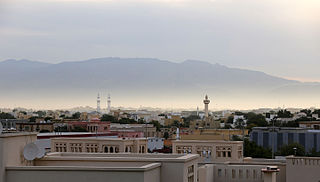
Jabal Al-Mebraḥ, also known by the name Jabal Yibir, is a 1,527 m (5,010 ft) tall mountain in the Emirate of Fujairah, the U.A.E.
The Shihuh is an Arab tribe living in the United Arab Emirates (UAE) and Oman. In the singular, the name is Al Shehhi, a common family name in the UAE and Oman today. Inhabiting the northern part of the Hajar Mountain range, specifically in the Ruus Al Jibal, the tribe has long been influential in the affairs of both the east and west coast settlements of the northern UAE and Oman and has fiercely maintained both its identity and independence.
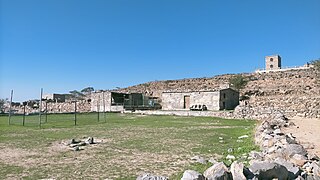
Baqal is a small agricultural and livestock town, located in the northeast of the United Arab Emirates (UAE), in the Al Hajar Mountains, Emirate of Ras al Khaimah.
Bani Shatair is a tribal name, originating in Ras Al Khaimah, in the United Arab Emirates (UAE) and in areas of Northern Oman.
Bani Hadiyah is a tribal name, originating in Ras Al Khaimah, in the United Arab Emirates (UAE) and in areas of Northern Oman.

Jabal ar Raḩraḩ is a peak in the Hajar Mountains, northeast of the United Arab Emirates, in the Emirate of Ras Al Khaimah. It has a height of 1,691 metres, and is situated entirely within the United Arab Emirates, at the coordinates 25.94419°N, 56.15219°E.
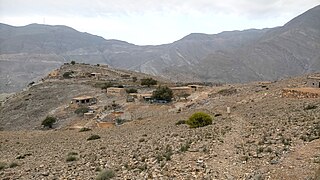
Musaibat is a small agricultural and livestock village, located in the northeast of the United Arab Emirates (UAE), in the Al Hajar Mountains, Emirate of Ras al Khaimah.
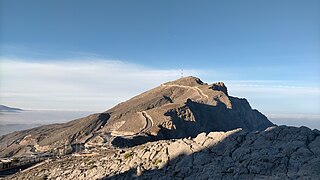
Jabal Raḩabah is a peak in the Hajar Mountains, northeast of the United Arab Emirates, in the Emirate of Ras Al Khaimah. At 1,543 m (5,062 ft), it is one of the highest peaks in the UAE, located entirely within the territory of the Emirates
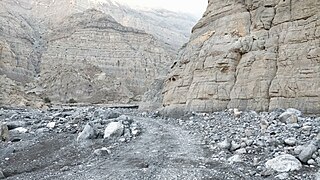
The Wadi Litibah is a valley or dry river, with intermittent flow, flowing almost exclusively during the rainy season, located northeast of the United Arab Emirates, in the Emirate of Ras al Khaimah.
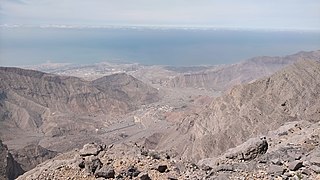
The Wadi Halhal is a valley or dry river, with intermittent flow, which flows almost exclusively during the rainy season, located in the northeast of the United Arab Emirates, in the Emirate of Ras al Khaimah.
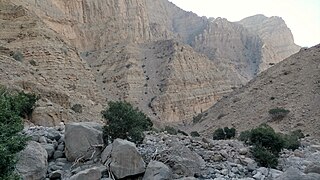
The Wadi Khabb is a valley or dry river, with intermittent flow, which flows almost exclusively during the rainy season, located in the northeast of the United Arab Emirates, in the Emirate of Ras al Khaimah.

The Wadi Ghalilah is a valley or dry river, with intermittent flow, which flows almost exclusively during the rainy season, located in the northeast of the United Arab Emirates, in the Emirate of Ras al Khaimah.

The Wadi Naqat is a valley or dry river, with intermittent flow, flowing almost exclusively during the rainy season, belonging to the river basin of the Wadi Bih,, northeast of the United Arab Emirates, in the Emirate of Ras al Khaimah.
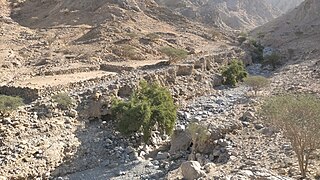
The Wadi Nahela, also known as Wādī Ghēl, Wadi Ghil, Wadi Nahail, Wadi Nahala, Wadi Nehaila or Wadi Nuhaila, is a dry valley or river with intermittent flow, which flows almost exclusively during the rainy season, located at the northeast of the United Arab Emirates, in the Emirate of Ras al Khaimah.

Jabal Al Harim or Jebel Al Harim is a peak located in the Al Hajar Mountains range, northwest of the Sultanate of Oman, in the Musandam Governorate.
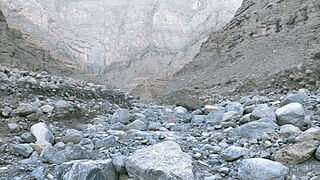
Wadi Rahabah, is a dry valley or river with intermittent flow, which flows almost exclusively during the rainy season, located in the northeast of the United Arab Emirates, in the Emirate of Ras Al Khaimah.
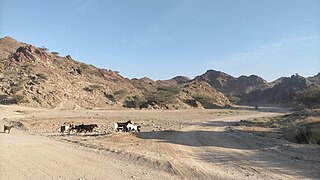
The Wadi Kub , is a dry valley or river with intermittent flow, which flows almost exclusively during the rainy season, located northeast of the United Arab Emirates, in the emirates of Fujairah and Ras al Khaimah.























